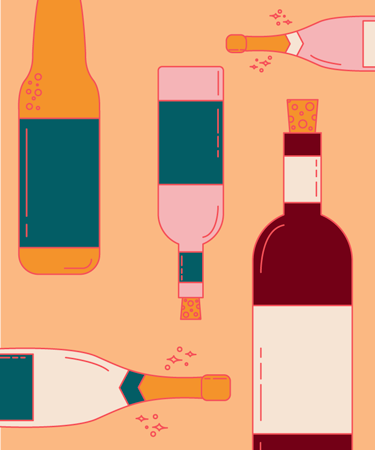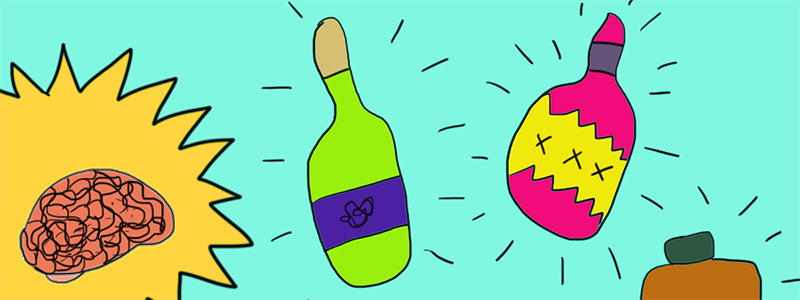My first job in the liquor industry was working as a Brand Ambassador for a craft distillery. Much of the job consisted of cold-pitching liquor stores and trying to get them to carry our products. I usually skipped the bodegas and discount joints in favor of stores that had a chic, high-end feel to them. These stores would often have craft products in their display windows, sparkling clean floors, and meticulously organized wines and spirits. Certain bottles would have descriptive blurbs tacked beneath them. Basically, I chose the booze store equivalents of handmade clothing purveyors.
One night, I was holding a tasting at one of these stores. It was located in an area of Brooklyn that was past the cusp of gentrification – basically as artisanal as a liquor store gets. There weren’t a whole lot of mainstream booze brands sold, and biodynamic wine a’plenty. I found myself behind the counter, pouring bourbon shots.
“Would you like to try some local whiskey?” I asked every customer who came in. More details of 100% New York corn and the positives of being a small operation followed.
Some would say yes, some no, but almost every person who came in that night bought the same thing: a nip (mini bottle) of the cheapest bourbon sold.
This experience repeated itself for me multiple times. I’d be hosting a liquor tasting or pitching a sale to a store owner, and one by one people would come in and buy nips of cheap liquor. It was almost comical, because I’d be delving into the detail of our distillery’s aging process and how that might appeal to consumers when someone would interrupt to buy cheap booze.
Me, to store manager: “It looks like you guys sell a lot of ‘Made in New York’ products – “
Customer: “A little thing of Svedka Peach, please.”
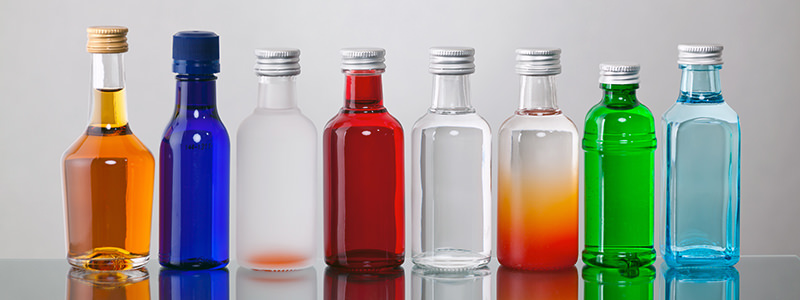
I don’t claim to know how every wine and liquor store is laid out, but after visiting a good chunk of them, this is what I’ve observed. Mid to high-end wine and liquor stores often show off their unusual or fancy products up front, while the dirt cheap liquor hangs out behind the counter. I suppose certain clothing stores do this, too. They have their new releases and general clothing supply in the store’s general area, and shlocky, cheap accessories corridoring your way to the cashier. The difference is, I could imagine H&M just selling clothes without the barrage of chapstick and 6-pack socks on the way to checkout. I cannot, however, imagine a wine and liquor store without 30 ml offerings of Kahlua. Not even a nicer, more expensive store.
But a good wine and liquor store wouldn’t be a wine and liquor store without, well, an actual store with variety and quality. So how does a wine and liquor store actually entice you to buy something new, something that you didn’t already set out to buy? Something that isn’t Svedka Peach.
The truth is, I think there’s a right way to do this and a common way to do this. I believe the smartest way to get customers to buy new, never-heard-of-em products is for the layout of a store to naturally guide customers in a way that makes them travel and discover, as opposed to search and navigate. I’ll explain what I mean. You see, this is how a lot of wine and liquor stores are laid out. See the figures below:
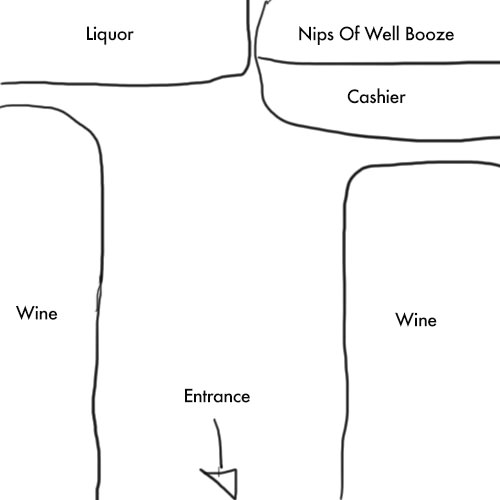
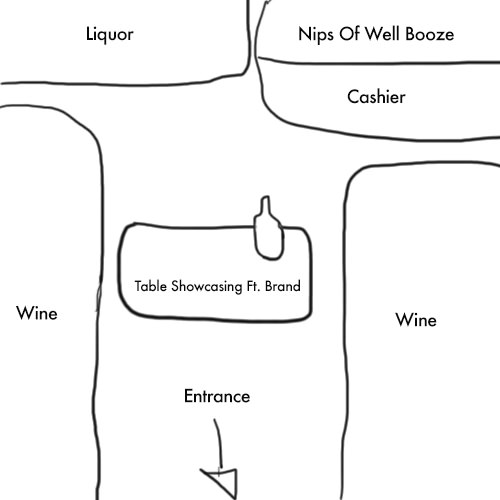
The liquor store in figure 1A offers no guidance. It’s simply walls stacked with options. In figure 1B, there’s one stagnant display table that is telling, instead of showing the customer what to buy, with no incentive for them to buy it. The display table in figure 1B was probably orchestrated through a talented Brand Ambassador who has a good relationship with the liquor store. Although the options in figures 1A or 1B may be organized (for instance, the wine is probably shelved by region), there’s nothing prompting you to explore something else, nothing making this experience interesting or spontaneous on its own. Unfortunately, a lot of liquor stores are like this. They may have an incredible selection, but selling it to people is immensely difficult. Now, part of that is because selling anything is difficult. An even larger part of that is because selling a new kind of wine or liquor to a person who thinks he knows what he wants is an almost insurmountable challenge. This is why good liquor stores seem to heavily rely on a) selling generic liquor and b) really talented salespeople.
But what if liquor stores were more like clothing stores in that they got you to window shop, browse, surprise yourself? I’ll refer here to one of my favorite stores that has small display tables dispersed neatly throughout the store. See below chart:
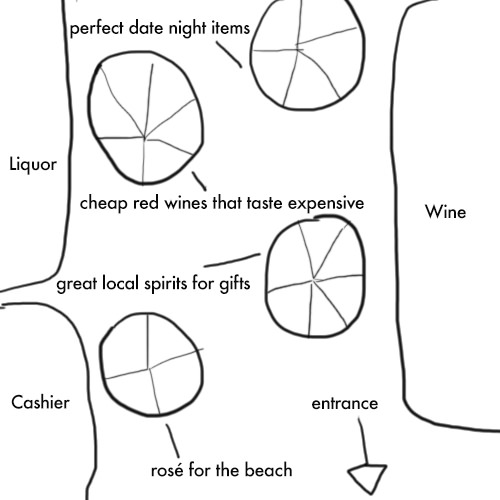
In figure 2, each table has a new theme, a theme you might want to explore, or not. Each theme has options. If you want to explore that theme, it gives you a variety of products to choose from, with an explanation for each one. Within each table, perhaps they’re organized by price, ABV strength, or something else the store manager came up with. If you don’t want to explore that theme, it’s only a matter of time before you bump into a new one. Either way, magnetizing yourself to the perimeter of the room or the cashier isn’t your first inclination.
Figure 2 is just one example of how to get people engaged while shopping for booze. Imagine setting up food and wine pairing displays (with fake food) to sell people different kinds of Bordeaux, or a small fake beach display to push new rums. Stores owners might scoff at these ideas and tell me I have no idea how to run a retail business, and they’re absolutely right about that. But I do know how people – especially people my age – shop. We want experiences. We don’t buy clothes just because they’re pretty, we buy them because we can imagine wearing them in different scenarios. At work, at a new bar, on a date. What if we could imagine wine and liquor the same way? Imagine if instead of going into a store thinking “I need to buy red wine and this is the only one I’ve heard of so I’m buying it,” we could walk into a store and think, “I’m having guests over and I need something that will please everyone. Oh look, here’s the ‘great buys for dinner parties’ section.”
It will be awhile until everyone enjoys spending a fair bit of time in a liquor store like I do. But I do think that wine and liquor stores need to rise to the challenge of making their wares more actively enticing and intriguing by display. Good sales associates will ever stop being needed, but they shouldn’t bear sole responsibility of piquing a customer’s interest in a product they didn’t beeline for. While alcohol brands have been marketing themselves as lifestyle items for decades, they’re doing it now more than ever. These brands are selling ideas, situations, the idea that if you drink this craft whiskey, you’re knowledgeable, smart, attractive. Wine and liquor stores should sell the same ideas. They shouldn’t just say “here, we have wine,” but “if you buy from this section, you’ll be sexy” or “you’ll have a gift that’s perfect for your boss.” If they don’t, lack of fun combined with the increasing legality and ease of online booze delivery services may make liquor stores more and more moot – and that still doesn’t get consumers to try new and exciting brands.
One day, maybe wine and liquor stores might no longer rely on the nips behind the counter and the well brands peppered about, just like H&M doesn’t actually need to sell those pink plastic hair-brushes.
